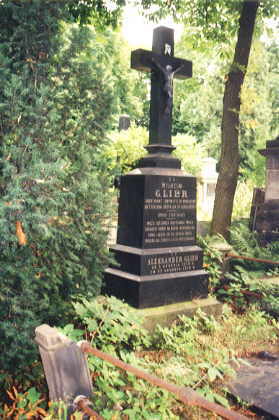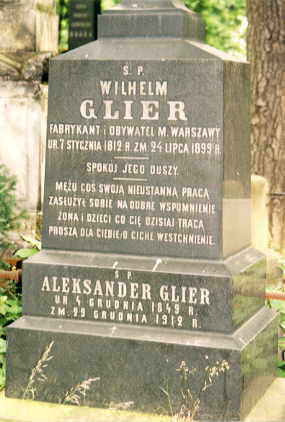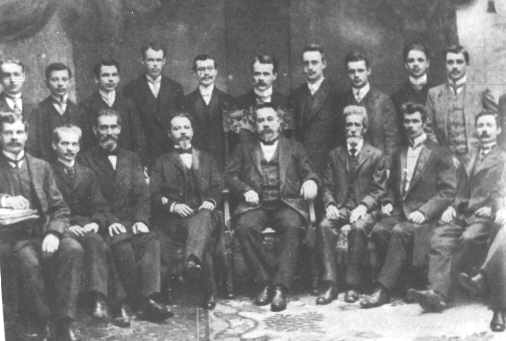|
|
|
.
|
The Glier family in Warsaw
* January 7, 1812 in Klingenthal (Saxony)
+ July 24, 1899 in Warsaw (Poland)
Friedrich Wilhelm Glier was raised in Klingenthal and Untersachsenberg.
He possibly learnt
the trade of the wind instrument making from his father Johann Gottlieb Glier (*1777 +1840).
Friedrich Wilhelm left Untersachsenberg and went to Warsaw. He was the founder
of the wind instrument factory which existed until World War II. Around the year
1834 he studied and worked in the wind instrument factory of Wilhelm Johann
Wernitz. In 1835 founded his own production factory in Warsaw, Bednarska St. 2673.
The factory was moved two times: around 1865 to Nowy-Swiat-St. 1293 (26) and
around 1890 to Aleja
Roz (Rose avenue) 4.
|
|
|
.
|
At the Warsaw Exhibition of 1845 he presented a set of wind instruments with piston valves, costing 2300 rubles and was ordered by the First Pioneer Reserve Bataillon. It consisted of 48 instruments, cornets, alto-bugles, basses (tubas). In 1860 he manufactured 25 instruments for 950 rubles for the Novorossijsk-Dragons-Regiment.
In 1864 Wilhelm Glier was arrested due to a report and had to pay 308 rubles because of selling some kind of whistles to Polish insurgents (January rebellion against Russia 1863-1864). At that time he also employed violin makers. Therefore some researchers (like Z.Szule) falsely ascribe him knowledge in the art of violin making. In 1880 he employed 8 instrument makers and the annual output had a value of 6290 rubles. In 1887 with about the same number of workers it was 7000 rubles. A year later (1888) Gliers compnay was awarded the gold medal "for diligence and art". In the Warsaw metal ware-exhibition of 1895 he was awarded the "Large Goldmedal".
From his marriage with Juliana Glier, nee Woroniecka, he had three sons (horn maker masters): Adolf, Friedrich and Alexander. The last one inherited the compnay of the father. Wilhelm Glier was buried on the Evangelical-Lutheran cemetery in Warsaw (grave monument # 27, aisle 10). A three-valves-horn with the signature "Wm Glier Fabrika v Varsavie s 1835" can be found in the Bate Collection (Oxford, England).


Grave of Wilhelm and Aleksander Glier on the Evangelical
cemetery (Cm. Ewang.-Augsburski),
Mlynarska Street 54,56,58 in Warsaw
|
HONORABLE
PEACE
HIS SOUL
BY HIS UNTIRING WORK HE MADE HIMSELF DESERVED IN THE MEMORY WIFE AND CHILDREN, WHO LOST YOU TODAY PRAY FOR YOU IN QUIET MOURNING
|
HONORABLE
ALEKSANDER GLIER
[Inscription of the memorial slab] + HONORABLE WILHELM GLIER LIVED 29 YEARS
WIFE AND CHILDREN PRAY IN MOURNING TO GOD |
Adolf learnt the wind instrument making from his father Wilhelm Glier. Around 1870 he is registered as a wind instrument journeyman at Muronowska Str.8, Warsaw. After a short activity in Warsaw he founded his own business in St. Petersburg. After 1900 he moved to Klingenthal, where he build instruments mainly to orders from the United States. In the Instrument Museum in Leningrad (St. Petersburg) there are two clarinets made of African Blackwood with the sign "Adolf Glier / St. Petersburg". In 1905 Adolf Glier lived at the Schweigerstrasse 5 in Dresden-Niederlössnitz (Saxony).
* December 4, 1849 in Warsaw
+ Dezember 29, 1912 in Warsaw
Alexander graduated from the Pankiewicz-Highschool and theWarsaw Conservatory in the clarinet class of Prof. Sobolewski. He learnt wind instrument making from his father. He worked as a military band leader in Krementschug (250 km southeast of Kiev) and later in Warsaw. He composed marches as well as other pieces of music for military wind instrument orchestra, of which one funeral song from 1863 is still played nowadays. Also he played in the orchestra of the Warsaw Music Society (a honourable institution for the Polish musical culture). After the death of his father he took over the instrument factory in 1895, which existed since 1835. He lead the factory for 13 years until his death in 1912. In 1904 he moved his factory to the Nowy-Swiat-St. 5 and in 1908 to the Smola St. 8 (the factory warehouse was on the Jerozolimska St. 72). In 1904 he employed 12, in 1908 24 specialists with an annual turnover of 35,000 rubles. In 1911 and 1912 his annual turnover was 50,000 rubles with 10 specialists. He got three big gold medals for his instruments in three exhibitions: in 1895 in Warsaw, 1907 in Petersburg and 1909 in Tschenstochau. His son Mieczyslaw inherited his fathers factory. Alexander was buried at the Evangelical-Lutheran Cemetery in Warsaw.

Alexander Glier amongst his workers. His son Mieczyslaw is in
the upper row (7th from left)
* March, 1, 1886 in Warsaw
+ February 26, 1979 in Warsaw
In 1905 he finished the secondary school and began his piano-playing studies at the conservatory of Warsaw, which he interrupted in 1908. At the same time he studied Math with Prof. Wladyslav Lewandowski, because he was playing with the thought to visit the Technical College. He learnt the wind instrument making at his fathers business under supervision of Master Antoni Romanowski since 1905. Before 1914 he took lessons in piano playing from Prof. Schoene and on wind instruments from his father. From 1913 til around 1942 he lead the factory, inherited from his father, in Warsaw, at first in the Smolna St. 3, since 1918 in the Tatrzanska St. (the shop was in the Jerozolimska Alley 77) and since 1921 in Ksiazeca St. 15. Before WW I Mieczyslaw exported his instruments to Russia. During the war most of the materials as well as machines were confiscated by the Germans and Mieczyslaw worked as an inspector in the supplies department of the municipal authorities of Warsaw. Between the WW's the business reached step by step its former splendid productivity. It began with a lathe and a machine to make pistons. Already in 1920 a set of instruments was produced for the 1th Chevauleger Regiment in Warsaw. The company delivered to the exhibitions in Poznan in 1929, in 1932 in Warsaw and in 1934 in Berlin. There nine instruments were honoured with certificates and sold to German musicians after the exhibition, who later expressed their satisfaction in letters of recommendation. In 1939 in New York was an exhibition of 17 instruments, among them a Sousephone, the American variety of the Helikon. At that time 25 workers were employed in the factory. Up to 1935 the manufactured instruments carried the sign "Warszawska Wytwornia Instrumentow Muzycznych (Warszawa) A.W. Glier (which means.: Warsaw Music Instrument Factory (Warsaw) A.W. Glier). From 1935 on there were signed: "M. Glier / Warszawa". Percussion instruments for wind instrument orchestra were manufactured. Since 1935 Mieczyslaw had a partner named Boleslaw Rudzki (Ltd.). During WW II a number of instruments including a lot of materials were confiscated by the Germans and Mieczyslaw was expelled to Tarnow (South Poland). In 1944 the factory and with it the collection of wind instruments of the 19th century were utterley destroyed. After the war Mieczyslaw Glier was one of the founders of the instrument making guild "Ton" (tone) in Warsaw and head of the department windhorn instruments. In 1958 he retired at the age of 72. He was married to Maria nee Michalski (1895-1965) and a second time to Lidia nee Sorokin, widowed Krylow. He is buried on the Powazki-Cemetery in Warsaw.
|